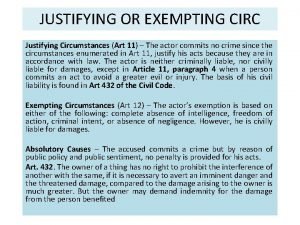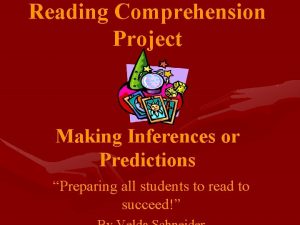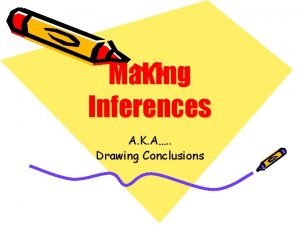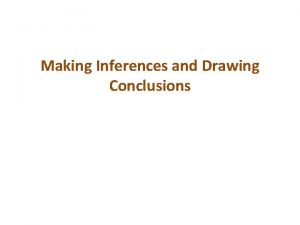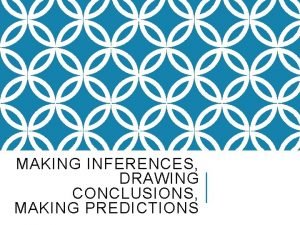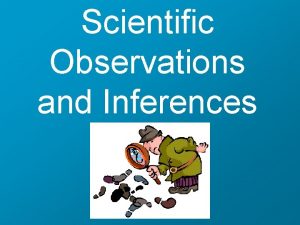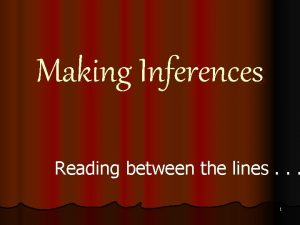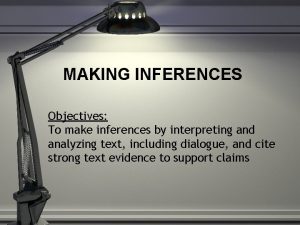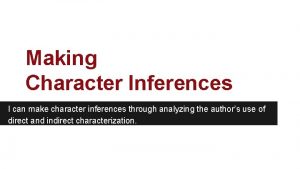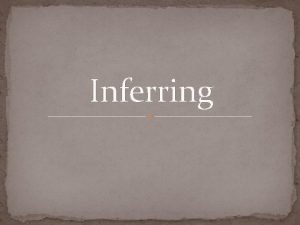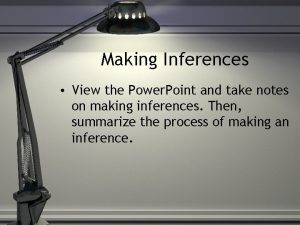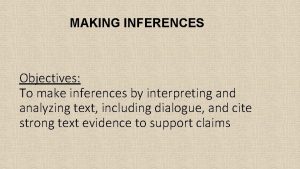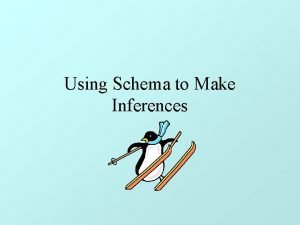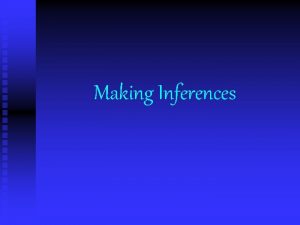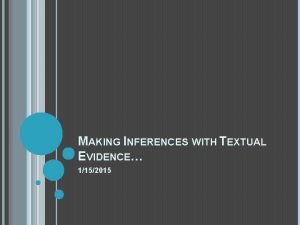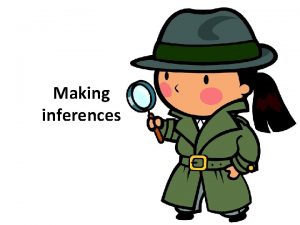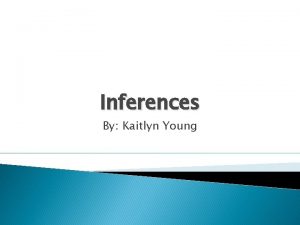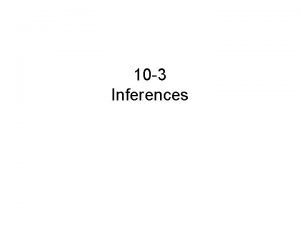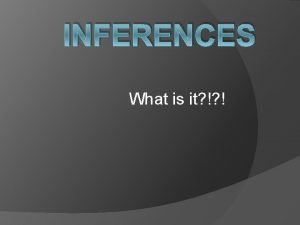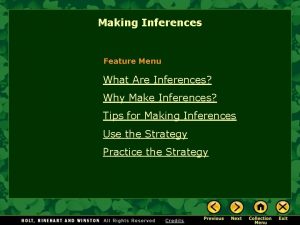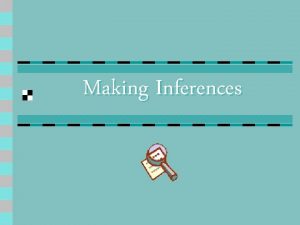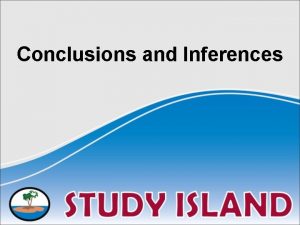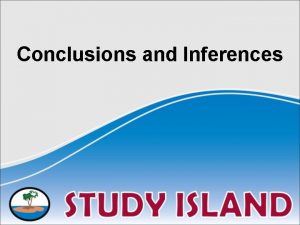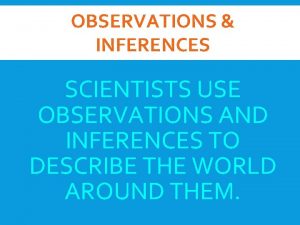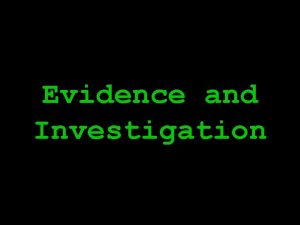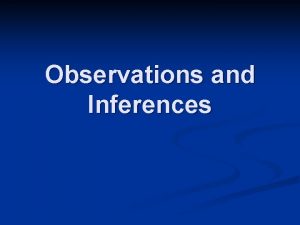Teaching the Common Core Making Inferences and Justifying

























- Slides: 25

Teaching the Common Core: Making Inferences and Justifying Conclusions Dr. Kari Lock Morgan Department of Statistics Penn State University ASA Webinar 2/25/15

Use data from a sample survey to estimate a population mean or proportion; develop a margin of error through the use of simulation methods for random sampling Use data from a randomized experiment to compare two treatments; use simulation to decide if differences between parameters are significant

What proportion of online adults use Facebook? Sample proportion: Population proportion: p = ? ? ? Key question: How far might the true p lie from this estimate? http: //www. pewinternet. org/2015/01/09/social-media-update-2014/ (January 9 th, 2015)

Margin of Error Estimates should come with a corresponding margin of error: statistic ± margin of error Margin of error: how far the true value might be from the sample statistic? Key point: To see how far the truth might be from the statistic, we see how far the statistic might be from the truth.

Simulate lots of random samples! �What would happen if we could take lots of different samples (each of size n = 1597) from the population of US online adults? �In order to do this, we would need to know the true p… for now, just use our best guess �Simulate many random samples! �www. lock 5 stat. com/statkey Free easy to use online (or offline as chrome app)

Distance from parameter to statistic gives distance from statistic to parameter p Margin of error depends on variability of the statistic Rare for statistics to be further than this from parameter So rare for parameter to be further than this from statistic margin of error

Standard Error The standard error of a statistic, SE, is the standard deviation of the sample statistic �The standard error measures how much the statistic varies from sample to sample �(or how far we expect statistics to fall from the true parameter)

The larger the SE, the larger the margin of error SE = 0. 15 Rare for statistics to be further than this from parameter SE = 0. 05 p SE = 0. 05 SE = 0. 15

95% of statistics will be within 2 SE of the true parameter value 2 SE truth 2 SE 95% of statistics We often use 2 standard errors as the margin of error

Interval Estimate A common interval estimate is statistic ± 2 SE (This is a 95% confidence interval, and will capture the true parameter for 95% of all samples generated. )

What proportion of online adults use Facebook? SE = 0. 011 Margin of error ≈ 2% � statistic ± 2 SE � 0. 71 ± 2(0. 011) � (0. 688, 0. 732) � We are 95% confident that between 68. 8% and 73. 2% of US adults who are online use Facebook.

Interval Estimation Population (? ? ? ) Sample Best Guess at Population Sample GOAL: Sample statistic ± ME Margin of Error (ME) (95% CI: ME = 2×SE) Standard Error (SE): standard deviation of the statistic Sample . . . Sample Distribution of the statistic Sample Calculate statistic for each sample

✔ Use data from a sample survey to estimate a population mean or proportion; develop a margin of error through the use of simulation methods for random sampling Use data from a randomized experiment to compare two treatments; use simulation to decide if differences between parameters are significant

Beer and Mosquitoes Does consuming beer attract mosquitoes? Experiment: 25 volunteers drank a liter of beer, 18 volunteers drank a liter of water Randomly assigned! Mosquitoes were caught in traps as they approached the volunteers. 1 Lefvre, T. , et. al. , “Beer Consumption Increases Human Attractiveness to Malaria Mosquitoes, ” PLo. S ONE, 2010; 5(3): e 9546. 1

Beer and Mosquitoes Data Number of Mosquitoes Beer 27 20 21 26 27 31 24 19 23 24 28 19 24 29 20 17 31 20 25 28 21 27 21 18 20 Water 21 22 15 12 21 16 19 15 24 19 23 13 22 20 24 18 20 22 Does drinking beer actually attract mosquitoes, or is the difference just due to random chance? Beer mean = 23. 6 Water mean = 19. 22 Beer mean – Water mean = 4. 38

Simulate random chance! Number of Mosquitoes Beer Water Beverage 27 20 21 26 27 31 24 19 23 24 28 19 24 29 20 17 31 20 25 28 21 27 21 18 20 21 21 22 22 15 15 12 12 21 21 16 16 19 19 15 15 24 24 19 19 23 23 13 13 22 22 20 20 24 24 18 18 20 20 22 22 Find out how extreme these results would be, if there were no difference between beer and water. What kinds of results would we see, just by random chance?

Simulate random chance! Number of Mosquitoes Beer Water Beverage 21 27 24 19 23 24 31 13 18 24 25 21 18 12 19 18 28 22 19 27 20 23 22 27 20 21 26 27 31 24 19 23 24 28 19 24 29 20 17 31 20 25 28 21 27 21 18 20 21 22 15 12 21 16 19 15 24 19 23 13 22 20 24 18 20 22 20 26 31 19 23 15 22 12 24 29 20 27 29 17 25 20 28 Find out how extreme these results would be, if there were no difference between beer and water. What kinds of results would we see, just by random chance? Calculate statistic (difference in means) Repeat thousands of times! www. lock 5 stat. com/statkey

Stat. Key Distribution of Statistic Assuming No Difference If there were no difference between beer and water regarding mosquito attraction, we would only get results this extreme 1 out of 1000 times P-value Proportion as extreme as observed statistic

Making a Conclusion • If there were no difference between beer and water regarding mosquito attraction, we would only get results this extreme 1 out of 1000 times • This is very unlikely to happen just by chance, so there probably is a difference! We have evidence that beer attracts mosquitoes. • (Because this would be unlikely to happen just by random chance, the difference is statistically significant).

Hormone Replacement Therapy �Until 2002, hormone replacement therapy (HRT) was commonly prescribed to post-menopausal women. This changed in 2002, when the results of a large clinical trial were published � 8506 women were randomized to take HRT, 8102 were randomized to placebo. 166 HRT and 124 placebo women developed invasive breast cancer �Does hormone replacement therapy cause increased risk of breast cancer? �How unlikely would this be, just by random chance, if there were no difference between HRT and placebo regarding invasive breast cancer?

HRT and Invasive Breast Cancer � If there were no difference between HRT and placebo regarding invasive breast cancer, we would only see results this extreme 2 out of 100 times. � We have evidence that HRT increases risk of invasive breast cancer.

Hormone Replacement Therapy �Same trial, different variable of interest. � 8506 women were randomized to take HRT, 8102 were randomized to placebo. 502 HRT and 458 placebo women developed any kind of cancer. �Does hormone replacement therapy cause increased risk of cancer in general? �How unlikely would this be, just by random chance, if there were no difference between HRT and placebo regarding cancer?

HRT and All Cancer � If there were no difference between HRT and placebo regarding cancer, we would see results this extreme about 24 out of 100 times, or about a quarter of the time. � We do not have evidence that HRT increases risk of cancer in general.

✔ Use data from a sample survey to estimate a population mean or proportion; develop a margin of error through the use of simulation methods for random sampling ✔ Use data from a randomized experiment to compare two treatments; use simulation to decide if differences between parameters are significant

Want more? � 2 ½ day workshops on teaching statistics in the common core (pending NSF funding) �When and where? (dates tentative) 2015 (New York): June 29 -July 1 or July 1 -3 2016 (Philadelphia): June 20 -22 or June 22 -24 2017 (Boston): June 19 -21 or June 21 -23 �Interested? Email me at klm 47@psu. edu Thanks for listening!
 Justifying circumstances
Justifying circumstances Making inferences and predictions
Making inferences and predictions Drawing conclusions and making inferences powerpoint
Drawing conclusions and making inferences powerpoint Example of drawing inferences
Example of drawing inferences When drawing conclusions, make sure you
When drawing conclusions, make sure you Blogical conclusion
Blogical conclusion Justifying grace
Justifying grace What are observations and inferences
What are observations and inferences Making inferences is reading between the lines
Making inferences is reading between the lines Inference objectives
Inference objectives Character inferences
Character inferences What is making inferences in reading
What is making inferences in reading Making inferences examples
Making inferences examples What is inference
What is inference Making inferences powerpoint
Making inferences powerpoint Inference objectives
Inference objectives Making inferences essential questions
Making inferences essential questions Making inferences with dialogue thank you ma'am
Making inferences with dialogue thank you ma'am Making inferences reading strategy
Making inferences reading strategy Brainpop making inferences
Brainpop making inferences The brittle, rocky outer layer of earth
The brittle, rocky outer layer of earth Inner core and outer core
Inner core and outer core Core rigidities
Core rigidities Technical core meaning
Technical core meaning Phases of micro teaching
Phases of micro teaching War making and state making as organized crime summary
War making and state making as organized crime summary
